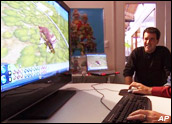
The final countdown to Sunday’s North American release of Electronic Arts’ long-delayed and highly anticipated “Spore” has begun. Fans in Europe will get their first crack at it on Friday. Spore will be available at retailers or via pre-download in the U.S. and Canada, selling for US$49.95.
The baby of Will Wright, creator of “The Sims” — the best-selling video game in history — “Spore” will have gamers spawning their own creatures and societies for many hours.
“Spore” takes players on an evolutionary journey from single-cell organism to landwalker; from a tribe to a civilization that eventually takes to the cosmos and explores galaxies. To get there, however, players will have to bite, claw, sing and dance as they fight for supremacy in an eat-or-be-eaten world.
With some 30 hours of gameplay under my belt at this point, I can say definitively that “Spore” is unlike any other game created for the PC.
Eat or Be Eaten
As gamers move through each stage of “Spore,” they essentially experience several iconic video games.
In the initial stage, as a unicellular organism, the goal is to eat as much as you can so that you can eventually walk on land. For those old enough to remember, this level is like a snazzier, more colorful and exciting “Pac-Man.”
Players swim through the primordial ooze of a vast tidepool on their chosen planet trying desperately to avoid being eaten by larger creatures, but avidly consuming anything smaller in order to grow. The only things missing here, nostalgia-wise, are the wonk, wonk, wonk chomping sound of Pac-Man and Blinky and company.
For anyone expecting to head straight to the “Creature Creator,” this stage may be a bit of a letdown. However, that frustration is quickly relieved once evolution has its way and what was a glob of hungry cells becomes a land-based carnivore, herbivore or omnivore.
The creature stage is where the game picks up, as players have the opportunity to style their own creature using parts they discover while exploring their new environment.
Gameplay here revolves around making allies or hunting other creatures into extinction. No matter which road players head down, the goal is to acquire DNA dollars that can be used to purchase different parts — eyes, mouths, arms and hands, legs and feet, wings, horns and tusks, etc. Selecting the right body parts is key, because they will affect the creature’s characteristics beyond this stage.
Moving to the tribal level, “Spore” begins to resemble strategy games such as Sid Meier’s “Civilization.” Gamers lead a gradually enlarging tribe as they seek to conquer their small patch of the world, either through alliances or aggression.
DNA points accrued by eating or domesticating “wild animals” and winning over or beating down the competition can be used to purchase weapons, musical instruments and fishing tools. Gameplay in this phase loses some of the creativity and fun of the creature stage, as players no longer have the ability to alter their creature. Instead, the game offers the opportunity to clothe them in items that can help achieve their goals.
Civil Discourse
The real-time strategy feel of “Spore” increases as the game moves into the civilization and space stages. The object for these levels is to gain control of the entire planet and colonize the universe, respectively.
Creature creation and adornment at this stage gives way to designing buildings, vehicles, aircraft, ships and other methods of transportation. Gone is the ability to directly control a creature. For this phase, players need to decide which course they will pursue in their bid for world domination — military, economic or religious.
The game now focuses on management more than anything else, with players building factories and houses, collecting currency, and maintaining the happiness of city dwellers.
The quest for global dominance becomes a bid to take over the galaxy in the fifth and final level. The action here centers on colonization. Players build a spaceship and travel the cosmos meeting other species, carrying out missions and colonizing new worlds.
The gameplay in this phase is reminiscent of the tribal stage, but it’s on a much larger scale, naturally. Resources need to be carefully conserved; choosing the wrong planet to colonize — one that requires a lot of sprucing up to make it livable — can quickly drain a player’s coffers.
Innovative and Entertaining
Overall, “Spore” is an entertaining game with some standout features. Giving players the ability to literally create their own world is groundbreaking. I’ve played a bunch of Sim civilization games, and usually the only choice you have is where to put the houses and businesses, etc. Being able to design my own content took a level of creativity that isn’t required in most video games.
I loved seeing creatures that I and other gamers had created and published on the Sporepedia included in the game. How cool is it knowing that other players will have a chance to see your creation?
Trying to make a game that will appeal to adults and children alike is no easy thing, as “Spore” proves. Some of the gameplay — post tribal stage — could be more evolved and complex.
That said, I look forward to spending many more hours exploring “Spore’s” sandbox and embarking on evolutionary quests.




















































